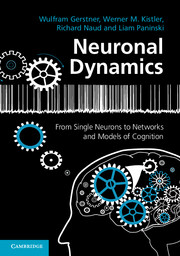Book contents
- Frontmatter
- Contents
- Preface
- PART ONE FOUNDATIONS OF NEURONAL DYNAMICS
- PART TWO GENERALIZED INTEGRATE-AND-FIRE NEURONS
- 5 Nonlinear integrate-and-fire models
- 6 Adaptation and firing patterns
- 7 Variability of spike trains and neural codes
- 8 Noisy input models: barrage of spike arrivals
- 9 Noisy output: escape rate and soft threshold
- 10 Estimating parameters of probabilistic neuron models
- 11 Encoding and decoding with stochastic neuron models
- PART THREE NETWORKS OF NEURONS AND POPULATION ACTIVITY
- PART FOUR DYNAMICS OF COGNITION
- References
- Index
6 - Adaptation and firing patterns
Published online by Cambridge University Press: 05 August 2014
- Frontmatter
- Contents
- Preface
- PART ONE FOUNDATIONS OF NEURONAL DYNAMICS
- PART TWO GENERALIZED INTEGRATE-AND-FIRE NEURONS
- 5 Nonlinear integrate-and-fire models
- 6 Adaptation and firing patterns
- 7 Variability of spike trains and neural codes
- 8 Noisy input models: barrage of spike arrivals
- 9 Noisy output: escape rate and soft threshold
- 10 Estimating parameters of probabilistic neuron models
- 11 Encoding and decoding with stochastic neuron models
- PART THREE NETWORKS OF NEURONS AND POPULATION ACTIVITY
- PART FOUR DYNAMICS OF COGNITION
- References
- Index
Summary
When an experimenter injects a strong step current into the soma of a neuron, the response consists of a series of spikes separated by long or short intervals. The stereotypical arrangement of short, long or very long interspike intervals defines the neuronal firing pattern. In Chapter 2 we have already encountered firing patterns such as tonic, adapting, or delayed spike firing. In addition to these, several variants of burst firing have also been observed in real neurons (see Fig. 6.1). This diversity of firing patterns can be explained, to a large extent, by adaptation mechanisms which in turn depend on the zoo of available ion channels (Chapter 2) and neuronal anatomy (Chapter 3).
In order to describe firing patterns, and in particular adaptation, in a transparent mathematical framework, we start in this chapter with the simplified model of spike initiation from Chapter 5 and include a phenomenological equation for subthreshold and spiketriggered adaptation. The resulting model is called the adaptive exponential integrate-andfire (AdEx; Section 6.1). We then use this simple model to explain the main firing patterns (Section 6.2). In Section 6.3, we describe how the parameters of the subthreshold and spike-triggered adaptation reflect the contribution of various ion channels and of dendritic morphology. Finally, we introduce the Spike Response Model (SRM; Section 6.4) as a transparent framework to describe neuronal dynamics. The Spike Response Model will serve as a starting point for the Generalized Linear Models which we will discuss later, in Chapter 9.
Information
- Type
- Chapter
- Information
- Neuronal DynamicsFrom Single Neurons to Networks and Models of Cognition, pp. 136 - 167Publisher: Cambridge University PressPrint publication year: 2014
Accessibility standard: Unknown
Why this information is here
This section outlines the accessibility features of this content - including support for screen readers, full keyboard navigation and high-contrast display options. This may not be relevant for you.Accessibility Information
- 1
- Cited by
